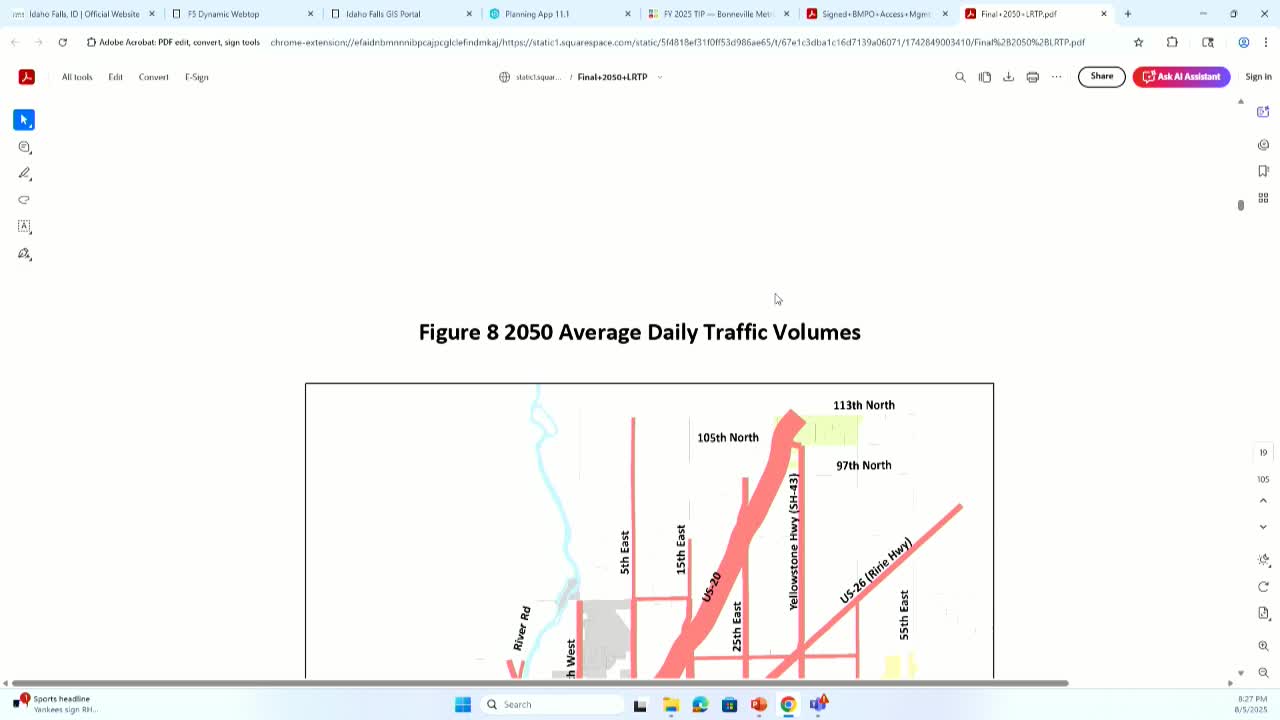Idaho Falls Discusses Future Traffic Volume and Access Management Strategies
August 05, 2025 | Idaho Falls, Bonneville County, Idaho
This article was created by AI summarizing key points discussed. AI makes mistakes, so for full details and context, please refer to the video of the full meeting. Please report any errors so we can fix them. Report an error »

Traffic management and urban planning took center stage at the Idaho Falls City Planning Commission meeting on August 5, 2025, as officials discussed the city's growing transportation needs and the implementation of a new access management plan.
The meeting highlighted the importance of understanding traffic volumes and patterns as Idaho Falls continues to expand. A representative from the city explained that the city collaborates with BNVO, utilizing a Geographic Information System (GIS) model to analyze traffic growth and density based on the comprehensive plan and zoning regulations. This data-driven approach aims to ensure that the city can effectively manage increased traffic while maintaining safety and accessibility.
A key focus was the introduction of a new "strategic arterial" classification, designed to handle higher traffic volumes with fewer access points. This classification aims to improve traffic flow and reduce congestion, particularly on busy routes. The plan emphasizes the need for coordination with neighboring areas, such as Ammon, to ensure consistency in road design and functionality.
The access management plan, which is regulatory in nature, aims to limit the number of access points for new developments. Officials noted that this approach is crucial for maintaining the efficiency of major roadways. For instance, when properties change use, the city can require the closure of excess access points to streamline traffic movement.
The meeting also touched on specific examples of recent improvements, such as the installation of center barriers to manage turning traffic more effectively. These measures are part of a broader strategy to enhance road safety and functionality across the city.
As Idaho Falls continues to grow, the discussions at the Planning Commission underscore the city's commitment to proactive urban planning and traffic management, ensuring that infrastructure keeps pace with development. The next steps will involve further collaboration with stakeholders to refine these plans and implement necessary changes to the city's transportation network.
The meeting highlighted the importance of understanding traffic volumes and patterns as Idaho Falls continues to expand. A representative from the city explained that the city collaborates with BNVO, utilizing a Geographic Information System (GIS) model to analyze traffic growth and density based on the comprehensive plan and zoning regulations. This data-driven approach aims to ensure that the city can effectively manage increased traffic while maintaining safety and accessibility.
A key focus was the introduction of a new "strategic arterial" classification, designed to handle higher traffic volumes with fewer access points. This classification aims to improve traffic flow and reduce congestion, particularly on busy routes. The plan emphasizes the need for coordination with neighboring areas, such as Ammon, to ensure consistency in road design and functionality.
The access management plan, which is regulatory in nature, aims to limit the number of access points for new developments. Officials noted that this approach is crucial for maintaining the efficiency of major roadways. For instance, when properties change use, the city can require the closure of excess access points to streamline traffic movement.
The meeting also touched on specific examples of recent improvements, such as the installation of center barriers to manage turning traffic more effectively. These measures are part of a broader strategy to enhance road safety and functionality across the city.
As Idaho Falls continues to grow, the discussions at the Planning Commission underscore the city's commitment to proactive urban planning and traffic management, ensuring that infrastructure keeps pace with development. The next steps will involve further collaboration with stakeholders to refine these plans and implement necessary changes to the city's transportation network.
View full meeting
This article is based on a recent meeting—watch the full video and explore the complete transcript for deeper insights into the discussion.
View full meeting